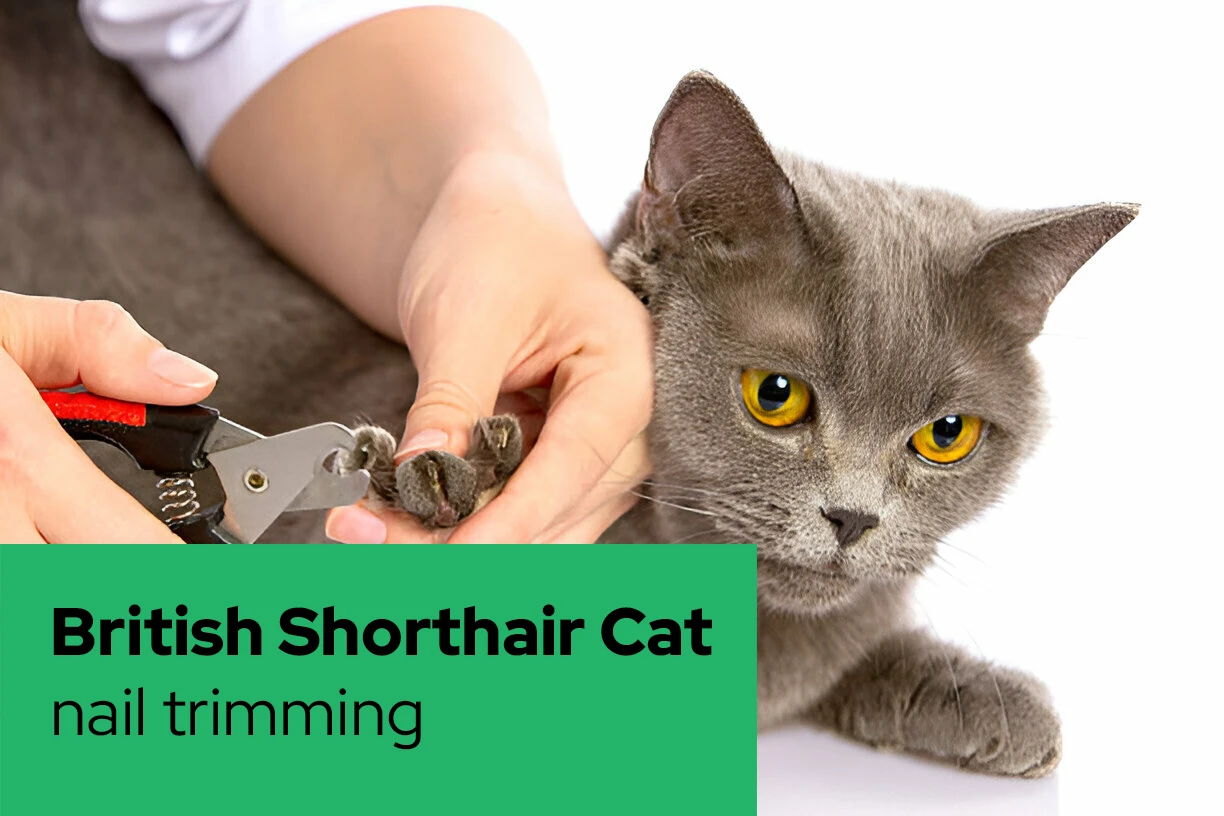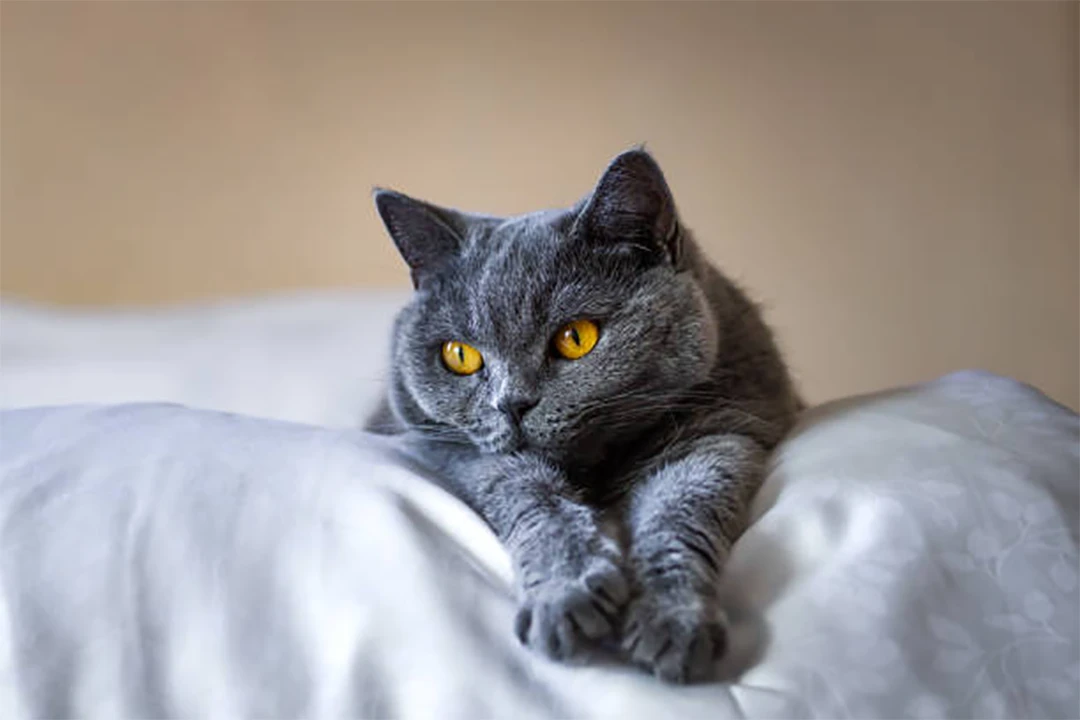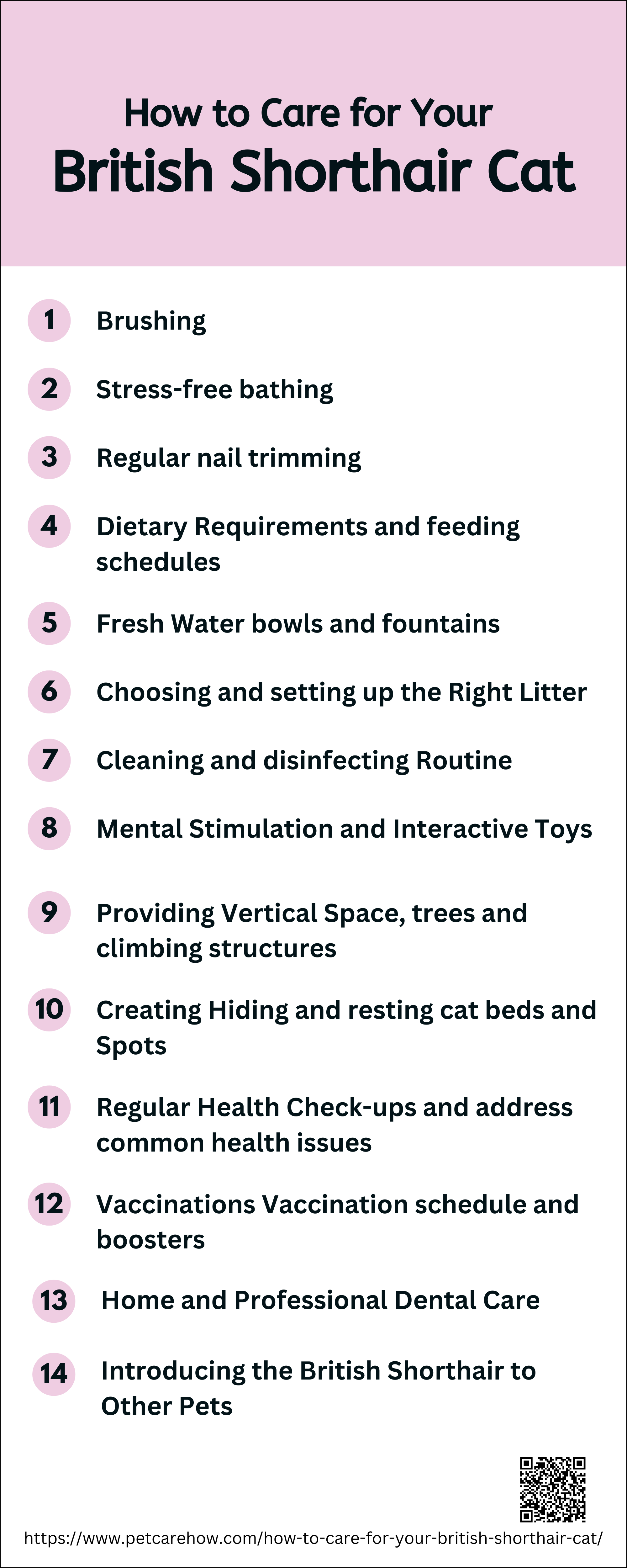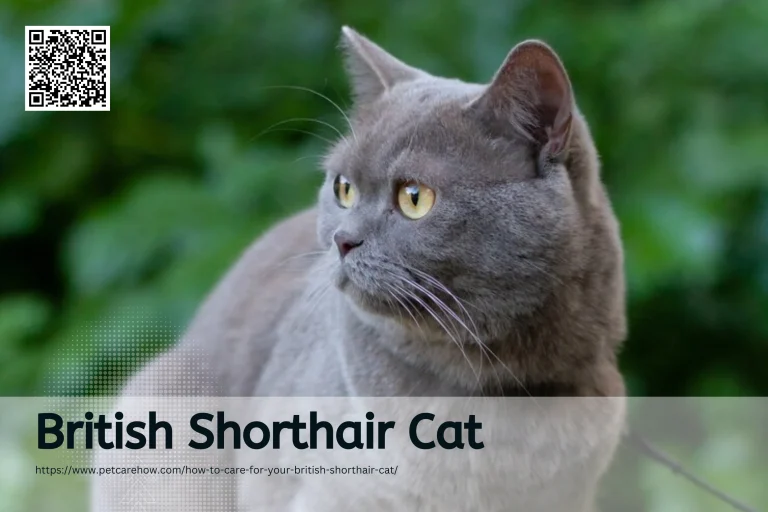The British Shorthair cat, with its plush coat and round, expressive eyes, is a beloved breed known for its calm demeanor and affectionate nature. Whether you’re a first-time cat owner or an experienced feline enthusiast, understanding the specific needs of this charming breed is essential for ensuring their health and happiness. In this comprehensive guide, we’ll explore the key aspects of British Shorthair cat care, from diet and grooming to health considerations and creating a stimulating environment. By following these expert tips, you’ll be well-equipped to provide your British Shorthair with the best possible care, fostering a strong bond and a fulfilling life together.
About British Shorthair Cat
The British Shorthair, often recognized for its robust and plush appearance, is a medium to large-sized cat breed known for its calm and easygoing temperament. Originating from the United Kingdom, this breed features a compact, well-balanced, and powerful body with a distinctive rounded head, chubby cheeks, and large, round eyes that contribute to its teddy bear-like appearance. The coat is short, dense, and comes in a variety of colors and patterns, including the classic British Blue, a rich gray color that is among the most popular. Historically, the British Shorthair is one of the oldest cat breeds in Britain, initially bred from street cats and later refined with crosses to Persian and Russian Blue cats. This breed is known for being particularly affectionate and loyal, making it an excellent family pet that gets along well with children and other animals. In terms of care, the British Shorthair requires minimal grooming, thanks to its short coat, but regular brushing is recommended to manage shedding. Overall, the British Shorthair is a beloved companion known for its striking appearance and gentle demeanor.
How to care your British Shorthair Cat
Got a British Shorthair cat? You’ve got a real gem! Ensuring your British Shorthair is happy and healthy can be easy if you know what to do. In this guide, you’ll discover tips for grooming, feeding, and playing that will keep your feline friend content. Let’s explore how to give your British Shorthair the best care possible.
1. Brushing
Due to their dense and plush coat, it is recommended to brush these cats at least once a week to help distribute natural oils, remove loose fur, and prevent matting. During shedding seasons, which typically occur around April/May and September/October, increasing the brushing frequency to twice a week can significantly help manage the shedding. Utilizing a coarse metal comb and a slicker brush is ideal for effectively grooming a British Shorthair’s thick undercoat, ensuring the cat’s coat remains healthy and vibrant. Regular brushing not only keeps the British Shorthair’s coat in excellent condition but also provides a wonderful opportunity for bonding, making it an enjoyable experience for both the cat and its owner.
2. Stress-free bathing
Bathing a British Shorthair cat is generally not necessary unless specific circumstances arise, such as the cat getting excessively dirty, having fleas, or for allergy management. These cats have dense fur that can trap allergens; therefore, occasional baths might help reduce allergen levels for sensitive individuals. When bathing is required, it should be done with care using lukewarm water and cat-specific shampoo to protect the cat’s skin and coat. Always ensure the bathing process is calm and quick to minimize stress for the cat, and thoroughly dry the cat afterwards to prevent any cold or discomfort.
3. Regular nail trimming

Regular nail trimming is crucial for maintaining the health and comfort of a British Shorthair cat. Ideally, their nails should be trimmed every two to three weeks to prevent overgrowth and the associated risks, such as ingrown nails or accidental scratches. When trimming, it’s essential to use the appropriate tools. Small, sharp cat nail clippers are recommended, and you can choose from scissor-style, guillotine, or plier-style clippers based on what feels most comfortable for both you and your cat. The technique involves gently pressing the cat’s paw to extend the nail, ensuring you only cut the white tip of the nail to avoid the quick, which can cause pain and bleeding if cut. To make the process smoother, acclimate your cat to the tools and handling by regularly touching their paws and rewarding them with treats. This preparation helps minimize stress and resistance during the actual trimming. Additionally, using a file to smooth the nails after clipping can prevent them from snagging on fabrics and furniture.
4. Dietary Requirements and feeding schedules
British Shorthair cats have specific dietary requirements that are crucial to maintaining their health and well-being. Due to their robust build and tendency towards obesity, it’s essential to manage their diet carefully. High-quality protein should be the cornerstone of their diet, with named meats like chicken or fish as the primary ingredient. This breed benefits from a diet that includes both wet and dry food, as wet food helps increase their water intake and supports urinary health, while dry food can aid in maintaining dental health by reducing tartar buildup.
Feeding schedules for British Shorthairs should include 2-3 meals per day, depending on their age, weight, and activity level. Consistency in meal times helps regulate their metabolism and prevents overeating. Portion control is critical; for adult cats, the amount of food should be based on their weight and energy needs, with adjustments made for less active cats to avoid weight gain.
Regular veterinary check-ups are recommended to tailor the diet as needed and to monitor the cat’s health, especially as they age or if any health issues arise. In summary, a balanced diet rich in high-quality proteins, managed portion sizes, and a consistent feeding schedule are key to supporting the health and longevity of a British Shorthair cat.
5. Fresh Water bowls and fountains
For British Shorthair cats, ensuring access to fresh water is crucial for their health and hydration. Given their dense fur and robust build, these cats can be prone to dehydration if not encouraged to drink regularly. Fresh water bowls and fountains can play a significant role in promoting adequate water intake. A variety of water bowls and fountains are available, designed to cater to the unique preferences of cats. Stainless steel or ceramic bowls are recommended over plastic to avoid potential bacterial buildup and to prevent feline acne. Water fountains, on the other hand, can be particularly appealing to British Shorthairs and other cats due to the movement of the water, which can stimulate their interest in drinking. Fountains also keep the water filtered and aerated, ensuring it stays fresh longer. When choosing a fountain, options with quiet operation are preferable to avoid deterring the cat from drinking. Regular cleaning and maintenance of both bowls and fountains are essential to ensure the water remains clean and safe for consumption.
6. Choosing and setting up the Right Litter
Choosing and setting up the right litter box for a British Shorthair cat involves several important considerations to ensure the comfort and health of the cat. British Shorthairs are medium to large-sized cats, so the litter box should be appropriately sized. It is recommended that the litter box be 1.5 times the length of the cat (excluding the tail) and as wide as the cat is long. This size allows the cat to turn around comfortably and perform its natural behaviors without feeling cramped. The location of the litter box is also crucial. It should be placed in a quiet, low-traffic area where the cat feels safe and undisturbed. Avoid placing the litter box near the cat’s food and water dishes, as cats prefer these areas to be separate. Additionally, if you have multiple cats, each should have their own litter box, plus one extra, to prevent any territorial stress. When it comes to the type of litter, most cats prefer a fine-grained, unscented litter that mimics the texture of sand, which is easier on their paws and more effective at odor control. Clumping litter is often preferred because it is easier to clean, maintaining a cleaner environment for both the cat and the home. Regular maintenance of the litter box is essential. It should be scooped daily and cleaned thoroughly at least once a week to prevent odors and maintain hygiene. Using a litter mat around the box can also help in keeping the area clean by catching any litter stuck to the cat’s paws.
7. Cleaning and disinfecting Routine
British Shorthair cats are known for their dense and plush coats, which require regular grooming to maintain their health and appearance. Typically, brushing should be done at least once a week to remove loose hair and prevent matting. During shedding seasons, more frequent brushing may be necessary to manage increased hair loss. Bathing should be infrequent, as British Shorthairs generally keep themselves clean and over-bathing can strip their coat of natural oils. When a bath is necessary, use a high-quality cat shampoo and ensures the water is at a comfortable temperature.
For ear cleaning, it’s advisable to check and clean the British Shorthair’s ears regularly to prevent wax buildup and potential infections. Use a vet-approved ear cleaner and a cotton ball or soft gauze to gently wipe the inside of the ears. Avoid using cotton swabs which can damage the ear canal.
Eye care is also important, especially since some British Shorthairs can develop tear stains. Use a soft, damp cloth to gently wipe any discharge from around the eyes. This routine helps prevent any blockage of the tear ducts and keeps the eyes clean and clear. Overall, maintaining a regular grooming schedule not only keeps your British Shorthair looking good but also provides an opportunity to check for any signs of skin problems or parasites, ensuring your cat stay healthy and comfortable
8. Mental Stimulation and Interactive Toys
British Shorthair cats, known for their calm and affectionate nature, require mental stimulation to stay healthy and engaged. Interactive toys play a crucial role in providing this stimulation, helping to prevent boredom and promote physical activity. Toys that mimic natural prey, such as feather wands or laser pointers, are particularly effective as they tap into the British Shorthair’s innate hunting instincts. Additionally, puzzle toys and treat-dispensing games can challenge their intelligence, keeping their minds active and engaged. Regular playtime with these toys not only enhances their mental well-being but also strengthens the bond between the cat and its owner, making interactive toys an essential part of a British Shorthair’s daily routine.
9. Providing Vertical Space, trees and climbing structures
British Shorthair cats, known for their easygoing nature and robust build, benefit significantly from vertical space, such as cat trees and climbing structures. These amenities cater to their instinctual need to survey their surroundings from a height, providing both physical exercise and mental stimulation. A well-chosen cat tree should be sturdy and spacious enough to accommodate the British Shorthair’s larger size and weight. Features to look for include multiple levels, a stable base to prevent tipping, and various textures like sisal for scratching, which helps keep their claws in good condition. Additionally, incorporating perches and hammocks can offer comfortable resting spots. For those with space constraints, wall-mounted options can maximize vertical space without occupying floor area. Ensuring these structures are safe and secure is paramount to prevent any injuries during use.
10. Creating Hiding and resting cat beds and Spots
 British Shorthair cats, with their calm and placid nature, often seek cozy and secure spots within the home to rest and hide. These feline friends cherish their privacy and comfort, making it essential for pet owners to create suitable hiding and resting areas that cater to their needs. A well-thought-out arrangement of cat beds, boxes, and perches can significantly enhance their sense of security and well-being. For instance, incorporating cat trees that offer various levels for climbing, resting, and observing can satisfy their curiosity and need for a high vantage point. Additionally, placing soft, washable beds in quiet corners provides a snug retreat for when they seek solitude. Cardboard boxes, a simple yet effective option, can be strategically placed around the house to serve as instant hiding spots. Ensuring these areas is accessible and away from the hustle and bustle of the household can make a world of difference in your British Shorthair’s comfort and happiness. By understanding and catering to their natural behaviors and preferences, such as their tendency to seek out cozy hiding spots, pet owners can create a nurturing environment that their British Shorthairs will love.
British Shorthair cats, with their calm and placid nature, often seek cozy and secure spots within the home to rest and hide. These feline friends cherish their privacy and comfort, making it essential for pet owners to create suitable hiding and resting areas that cater to their needs. A well-thought-out arrangement of cat beds, boxes, and perches can significantly enhance their sense of security and well-being. For instance, incorporating cat trees that offer various levels for climbing, resting, and observing can satisfy their curiosity and need for a high vantage point. Additionally, placing soft, washable beds in quiet corners provides a snug retreat for when they seek solitude. Cardboard boxes, a simple yet effective option, can be strategically placed around the house to serve as instant hiding spots. Ensuring these areas is accessible and away from the hustle and bustle of the household can make a world of difference in your British Shorthair’s comfort and happiness. By understanding and catering to their natural behaviors and preferences, such as their tendency to seek out cozy hiding spots, pet owners can create a nurturing environment that their British Shorthairs will love.
11. Regular Health Check-ups and address common health issues
British Shorthair cats are cherished for their charming demeanor and robust build, making them a popular choice among cat enthusiasts. However, like all breeds, they are predisposed to certain health issues that require vigilant care and regular veterinary check-ups to ensure a long, healthy life. Hypertrophic Cardiomyopathy (HCM) is the most common heart disease in cats, including British Shorthairs, characterized by the thickening of the heart muscle which can lead to severe health complications. Polycystic Kidney Disease (PKD), another genetic condition, leads to the formation of cysts in the kidneys and can cause renal failure. Feline Lower Urinary Tract Disease (FLUTD) and dental diseases are also prevalent in British Shorthairs, with FLUTD affecting the bladder and urethra and dental issues leading to potential systemic health problems if left untreated.
To address these common health issues, regular health check-ups are crucial. These check-ups allow for early detection and management of conditions such as HCM and PKD through routine blood and urine tests, as well as abdominal ultrasounds. Vaccinations play a vital role in preventing infectious diseases, and a tailored vaccination schedule should be discussed with a veterinarian. A balanced diet and regular exercise are essential in preventing obesity, a common problem in British Shorthairs that can exacerbate other health issues. Dental care, including regular brushing and veterinary dental check-ups, is necessary to prevent dental diseases.
12. Vaccinations Vaccination schedule and boosters
British Shorthair cats, like all cats, require vaccinations to protect against various diseases. The initial vaccination schedule for a British Shorthair kitten typically begins at around 6 to 8 weeks of age with the first dose of the core vaccines, which include feline distemper (panleukopenia), feline herpesvirus (rhinotracheitis), and calicivirus. A second dose follows between 8 to 12 weeks, and at 12 weeks, they should receive another shot for upper respiratory infections and distemper. The rabies vaccine is usually administered when the kitten is around 12 to 16 weeks old.
Following the initial vaccinations, British Shorthairs should receive booster shots to maintain immunity. The core vaccines (rabies, feline distemper, rhinotracheitis, and calicivirus) are generally boosted once every three years, although some may require annual boosters depending on the specific vaccine used and the cat’s risk of exposure. Non-core vaccines, such as those for feline leukemia virus (FeLV), are recommended based on the cat’s lifestyle and risk factors, with boosters typically given annually for cats at higher risk.
It’s important for pet owners to discuss their British Shorthair’s specific health needs and risks with their veterinarian to tailor an appropriate vaccination schedule. This ensures the cat remains protected against infectious diseases while minimizing the risk of over-vaccination.
13. Home and Professional Dental Care
British Shorthair cats, known for their charming demeanor and plush coats, also require attentive dental care to maintain their overall health and well-being. Home dental care is crucial and should include regular brushing with cat-specific toothpaste to prevent the buildup of plaque and tartar. Starting this routine early in the cat’s life can make the process easier, but it’s never too late to begin. Alongside home care, professional dental check-ups and cleanings are essential. Most cats, including British Shorthairs, need an annual dental examination and cleaning under anesthesia to thoroughly remove plaque and tartar, especially below the gum line, and to assess for any dental diseases or issues that might not be visible or apparent during home care. This combination of home and professional care helps prevent common dental problems such as gingivitis, periodontitis, and tooth resorption, ensuring your British Shorthair maintains a healthy mouth throughout its life.
14. Introducing the British Shorthair to Other Pets
The British Shorthair is known for its calm and easygoing temperament, making it an excellent candidate for a household with other pets. These cats are generally sociable and can coexist peacefully with dogs, especially if they are introduced properly and the dogs are not overly aggressive or energetic. When introducing a British Shorthair to dogs, it’s beneficial to choose dog breeds that are known for their calm demeanor and sociability, such as Beagles or Labrador Retrievers. For households with birds, while the British Shorthair’s laid-back nature is a plus, their basic predatory instincts could pose a risk to feathered pets. It’s crucial to never leave them unsupervised and to ensure that birds are securely caged to prevent any accidents. Similarly, when introducing a British Shorthair to another cat, gradual introduction processes involving scent swapping and controlled visual encounters can help in fostering a peaceful cohabitation. Overall, with careful introduction and consideration of each pet’s personality and instincts, a British Shorthair can be a delightful and harmonious addition to a multi-pet family.

Conclusion
Caring for a British Shorthair cat involves a blend of regular health check-ups, a balanced diet, and consistent grooming to maintain their plush coat. These cats, known for their calm and affectionate nature, thrive in environments that provide mental stimulation and moderate exercise. While they are generally healthy, regular veterinary visits are crucial to catch any potential health issues early. British Shorthairs are adaptable and can live comfortably in apartments, making them ideal companions for various households. By understanding and meeting their unique needs, you can ensure a happy and healthy life for your British Shorthair, fostering a strong and loving bond with your feline friend.

